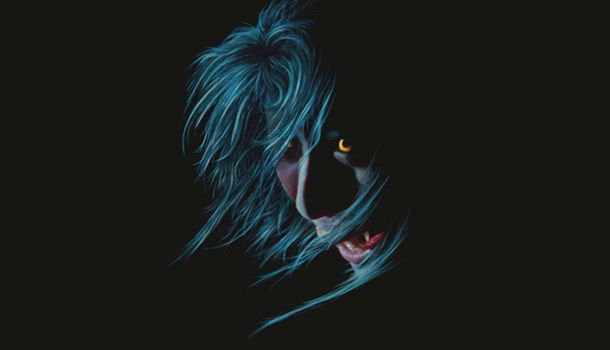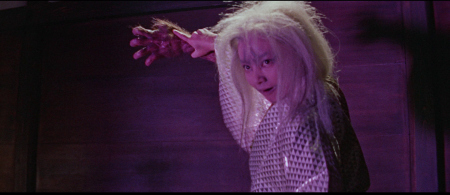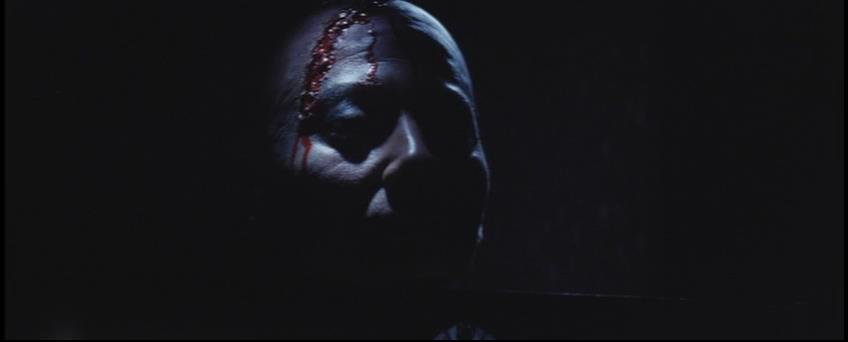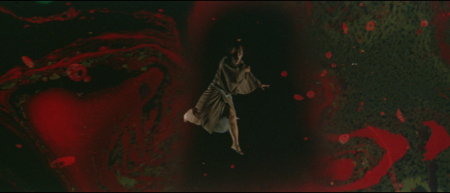
Written by Richard Durrance on 29 Oct 2025
Distributor Radiance • Certificate 15 • Price £44.99
Those that remember my words on the first Daiei Gothic boxset may recall that I was mightily pleased with it. Understandably, come the witching month of October, a second volume was announced to grace our shelves, providing us with three new films: two by The Snow Woman and The Betrayal director Tokuzo Tanaka: The Demon of Mount Oe (1960) and The Haunted Castle (1969); finally Kimiyoshi Yasuda’s The Ghost of Kasane Swamp (1970).
To be original I shall start us at the beginning, with the first film: The Demon of Mount Oe.
A wronged woman, Nagisa (Fujiko Yamamoto ), is sent to a samurai general, Raiko (Raizo Ichikawa), as a gift. A cursed gift in fact, for where she goes evil follows, an evil that takes Raiko’s own lover and pits him against the lord on Mount Oe, a mountain that no man has ever returned from. Raiko, ordered to scour the lands takes to the task. If only the lord of the mountain were quite so simple a villain.
The film opens intriguingly, with an act of theatre telling us what history recalls before tumbling into the past and into a film that, if anything, gets better and better with the telling. There is much here of the supernatural ghost story, but really this is a tale of the human heart. It’s also a deconstruction of mythic storytelling. It’s the kind of film that, as I watch it, I make mental notes to talk to this aspect and to that but also realise there is too much going on in my head to ever recall it all or hope to effectively recount; so I know essence is the point, to get across a sense of the film and also how deeply impressed I was by the end.
I say this because the film starts as a ghost story, a rollicking one at that with magical swords that detect evil, with a beautiful demon coming out of the ether, cursed lovers and even the odd scene which is highly improbable: Shintaro Katsu (yes, Zatoichi himself) as the samurai Watanabe no Tsuna letting in his aunt when protecting a demon’s arm is utterly absurd, but as the narrative unfolds what it reveals to us is a beautifully told, surprisingly nuanced drama of the heart. There may be ghosts, demons, even some samurai battles but the centre of the film is both a narrative pivoting on human feeling and how what history remembers is something deeply different from the truth, and the truth is far more engaging.
Having a few nights before been disappointed and slowly bored by the tedious monotony of Oppenheimer (the second half of which I abandoned for the numbing repetition), I was surprised just how, as the story moved forward, so did its sophistication and its pleasure. Layers peeled away, characters become fleshed out where they needed to be, and the world within which the story takes place really lived and breathed in a manner that it didn’t necessarily need to, which a less interesting film would abandon and instead go for the obvious narrative beats. Instead it interrogates our human beings placed in awful situations, amongst supernatural creatures, and ensures that our hearts beat in unison with the characters we are watching. This reaches such a pitch that by the end that there are some villains in our story - for to be certain villains there are - but those we expect to be the greatest evil are like the rest of us, just flawed human beings clinging to ideals that we all actually share. It’s a surprise, a shock and a pleasure of the rarest kind for a story to take on such nuance where it could, in lesser hands, be more easily told in broad strokes.
Shot in the studio this is very much a piece of artifice, down to even some of the effects, such as the demon bull which could almost be utterly risible, but the skilled filmmaking integrates it perfectly. You recognise the limited means of the effects but also how the artifice is so important, just as the way that the unnatural lighting is or the make-up which highlights a demon’s face is unreal. This is a film of heightened unreality and a dream for those that love cinema. Someone expecting modern effects will be disappointed, but that would be to miss the point and pleasure of the film.
This is also a film about the deconstruction of myth, of stripping back the imagined trappings to a story that is far more engaging than the myth likely ever could be; myth tends to work with archetypes while The Demon of Mount Oe takes these apart.

Whatever else you may think, The Demon of Mount Oe is arguably worth the price of the whole boxset alone. So what would I think of the second film: The Haunted Castle?
Following the murder of a blind man and his sister by a jealous lord, samurai retainer, Komori (Kojiro Hongo) is charged with ending the sinister haunting of the lord’s castle by the cat that sipped the blood of the dying sister.
Moving from a near two-hour film into an 80-minute piece shows how the director, Tanaka, is comfortable with the difference in filmmaking styles. The Demon of Mount Oe is a much more sprawling film, sometimes bordering on the Jidaigeki as much as it is a horror film, whereas The Haunted Castle is a much more traditional film. That said there is that black cat and such creatures have haunted cinema for decades, Kaneto Shindo’s Kuroneko being perhaps Japan’s most famous film (and am I the only person to prefer Kuroneko to Onibaba?) to include one but even films like Edgar G Ulmer’s 1934 film uses the title: The Black Cat even if cats have little to do with it (it’s also a brilliant, beautifully perverse film). The cat here though takes possession of various characters in a castle ruled by politics, because the lord and most of his retainers are all vying for their positions, whether to retain them where they feel they are under threat (imagined or otherwise), or jostling for power. So it is very much a tale that deals with morality, as our eventual protagonist is the model of a loyal retainer but also loyal to his dead friends. He is upright and I don’t think for a moment we can imagine his death because he is the moral centre of the film simply by dint of his existence.
So the film then becomes an exercise in cinema. Often beautifully filmed, an early image that is the catalyst for the story, of the blind brother and his sister sitting outside for a picnic is gorgeously framed, as are most of the most visually engaging moments as they are formally portrayed. Some of these really strike you, the contrast of the darkness and the glinting use of colour; for though a colour film as it progresses it is one suffused by darkness, shadows, and floating cat women. This insistence on the visual, rather than digging into the story, is a good thing because the story itself is pretty old hat, especially in comparison to the narrative deconstructions of The Demon of Mount Oe. So Tanaka has to rely on his visual skills to tell a compelling story, and this he does, though the musical score helps too, with its delicate orchestrations that underscore the unease of the film. As this is not outright horror, of course not, this is Daiei Gothic, this is cinema of the unease as opposed to cinema of the jump scare, it’s about seducing the audience with the tone of the film and this is where Tanaka focusses, on sucking you into his vision, whether the expressions on the women as they become hosts to the ghost cat or the dark corners of the titular castle, even if at heart it becomes a morality tale but we forgive, almost forget that because you enjoy the exercise in cinema.

If The Haunted Castle works out as a morality tale then The Ghost of Kasane Swamp is tale of immorality, as a blind masseur-cum money lender (Kenjiro Ishiyama) is killed by a dissolute samurai (Saburo Date). One of the masseur’s daughters, Oshiga (Maya Kitajima) steals money from her father’s home, not knowing of his death, while also becoming emotionally involved with the samurai’s equally dissolute son, Shingoro (Teruo Ishiyama).
There’s something of a "film of two parts" about The Ghost of Kasane Swamp, as it opens as a period drama for certain, but it feels very much of the late 60s, at times almost psychedelic in its use of colour, with painted swathes of colour and electric soundtrack. It also leans into the times and is more than a little lascivious. Whereas the prior films are more pure ghost stories, here you can tell the effect of Daiei trying to gain some traction outside what might have been some of their core audience with some more obvious flesh than is usual for such a story. But it nevertheless keeps its ghoulishness, as those murdered softly haunt the characters that start to enter our film.
Here though, the film changes as well, turning into more of a fevered and sometimes lurid melodrama. This is no bad thing, but it is a melodrama filled with characters of which very few indeed are likely to win your heart. It's a real rogues gallery of characters, willing to betray, sell out, use or murder; almost everyone is utterly out for their themselves. Even Oshiga, though upset to find news of her father’s death, is hardly cut up about it. Something in the elevated melodrama made me think of some of Masumura’s work for Daiei and the film could have used his touch a bit, as Masumura had a remarkable skill when it comes to heightening melodrama to levels almost touching absurdity but never crossing the boundaries of it (I mean, Manji should be ludicrous with it's lush eroticism). Don’t get me wrong, director Kimiyoshi Yasuda does a good job with it, but you suspect Masumura could really have turned this into something truly special.
Nevertheless, the ghostly aspects of the film almost entirely disappear for much of the story and the focus is on the escalating drama, focussing on the fortune and misfortune of our mismatched pair and those that they have wronged, and who have wronged them, until our finale where the swamp takes its victims. This is no surprise; there is nothing about the people we meet that makes you think things will ever turn out anything other than badly, but there is something fascinating in watching their wrong turns and the ever building sense of wrongness that surrounds them, the sense that just when they think they may have found themselves a good thing it all turns into pain as dreams crumble into dust.
This film was made towards the very end of Daiei, before it folded, and there is something in the film’s movement between genres that perhaps explains some of Daiei’s problems. it still looks to be a classy production - though is happy at times to show a little flesh - and get a little down and dirty. Masumura was better able to move within the darkness in more overt ways in films like Blind Beast and Play it Cool, while arguably darker still in Red Angel and Irezumi but always keeping that sense of creating a sophisticated product. So maybe The Ghost of Kasane Swamp is a good way for Daiei to have ended because it shows us the best of it, and to an extent where it couldn’t quite keep a footing in the new world.

And so Daiei Gothic vol 2 comes to an end with three films ranging across a decade. While Tanaka’s two films feel like they could have been made at any time within that period, Yasuda’s is a little more of its time, but these are still excellent titles to add to your collection. The films are shot in studios and embrace the artificiality of it; the colours and lighting are as you would expect, almost expressionistic at times and our demons are made-up effectively, even if often - such as in our final film - these hauntings are best when practiced in the shadows.
You suspect there’s a rich vein of films waiting to be mined here so I’m looking forward with hope to Radiance potentially announcing volume 3 for next year.

Long-time anime dilettante and general lover of cinema. Obsessive re-watcher of 'stuff'. Has issues with dubs. Will go off on tangents about other things that no one else cares about but is sadly passionate about. (Also, parentheses come as standard.) Looks curiously like Jo Shishido, hamster cheeks and all.
posted by Richard Durrance on 23 Oct 2025
posted by Richard Durrance on 13 Oct 2025
posted by Richard Durrance on 08 Oct 2025
posted by Richard Durrance on 25 Sep 2025
posted by Richard Durrance on 16 Sep 2025
posted by Richard Durrance on 10 Sep 2025
posted by Richard Durrance on 04 Sep 2025
posted by Richard Durrance on 03 Sep 2025